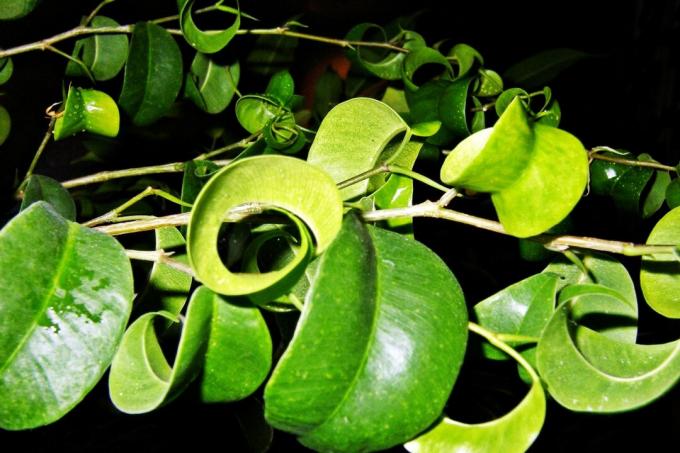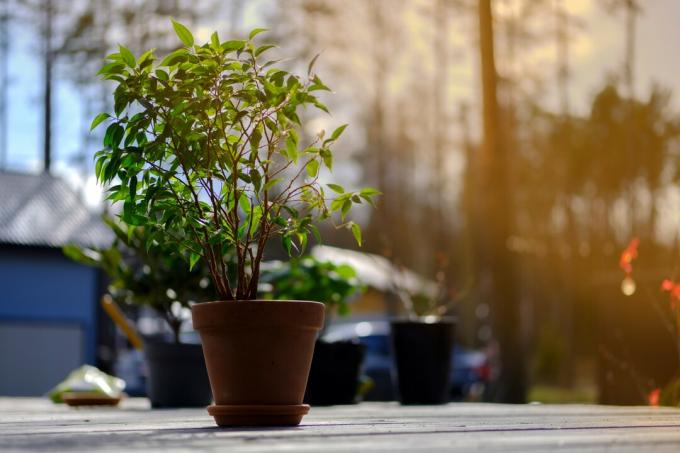The weeping fig is already known as a common office plant, because it is very popular due to its easy-care and air-purifying properties.

The weeping fig (Ficus benjamina) is an eye-catcher with its shiny foliage. In some varieties, the leaves can even be patterned. It is closely related to that Fig tree (Ficus carica) from which you can harvest edible fruits.
Note: Another common name for Ficus benjamina is "Bejamini". By mixing it with the Latin name, it is often used Ficus bejamini called, which is strictly speaking not correct.
contents
- Weeping fig: characteristics and origin
- The most beautiful varieties
- Planting Benjamini: location, soil and Co.
- wintering
- Propagate weeping fig
- Is the Benjamini poisonous?
Weeping fig: characteristics and origin
The weeping fig (Ficus benjamina) is an evergreen wood of the mulberry family (Moraceae). It can grow as a tree or as a shrub and forms slightly overhanging branches. It occurs naturally in Asia and northern Australia, but is a popular house plant here. In tropical areas it is also used outside as an ornamental wood and unfortunately behaves invasively there. It impresses with its shiny green foliage, which you can admire all year round. The leaves are entire, oblong-ovate and have a short stalk. At first they are light green and then later turn darker in color. The smooth, light gray bark also looks pretty. The different types of Benjamini, as the weeping fig is also called, are available in a wide variety of colors and patterns.

While the Benjamini reaches heights of around three meters as a houseplant, it can grow up to 18 meters in nature. The stately specimens in the wild develop numerous aerial roots. Smaller varieties of the weeping fig can even be kept as a bonsai. In our country the Benjamini very rarely forms flowers between August and September. However, these are very inconspicuous and only appear when the conditions are ideal. This is then later used to create the fruits, which do not look like typical figs, but are spherical and orange. The milky sap of the weeping fig contains allergens that are similar in structure to latex allergens. If you have a latex allergy, you should be particularly careful, as this can often lead to a cross allergy with the weeping fig. The allergens can even reach the leaf surface and thus get into the room air. In return, the Benjamini slightly reduces the level of pollutants such as formaldehyde in the air.
How old does a weeping fig get? It is not so easy to say how old a weeping fig will get. Of course, it also depends on the right care. In the tropics there are specimens that are several hundred years old and a proud age of 70 years is not uncommon for indoor plants.

The most beautiful varieties
The Ficus benjamina come in many forms, some are getting bigger, others are staying small. The foliage can be completely green or come in color variations with yellow, green and white. Varieties with light-colored leaves usually need more light, and completely green plants can also be in partial shade.
- Ficus benjamina "Natasja": The weeping fig ‘Natasja’ remains rather small, grows bushy and reaches a height of around 80 cm. The leaves are a beautiful, deep green.
- Ficus benjamina 'Baroque': The leaves of this variety are curled up and are somewhat reminiscent of curly hair. The plant grows compact.

- Ficus benjamina "Golden King": The foliage of this variety is variegated golden yellow-green or creamy white. It grows larger than 1 m, although growth can be limited by the size of the pot.
- Ficus benjamina "Twilight": Here you get leaves in light green with a white border. This variety can also grow larger and should be in a particularly bright place so that the brightly patterned foliage can develop well.

Planting Benjamini: location, soil and Co.
In order for the weeping fig to grow well and stay healthy, some location requirements should be taken into account. The Benjamini feels most comfortable at warm temperatures above 20 ° C; the temperature should never drop below 16 ° C. Weeping fig is also good at high humidity and can be achieved, for example, by regularly spraying the leaves. A bright bathroom is therefore a good place, but the weeping fig is also popular in the bedroom. Above all, a high level of humidity must be ensured there. A sheltered place is also advisable, as the Benjamini does not like drafts.
The question still remains, how much light does the weeping fig need? The Benjamini can tolerate direct sunlight in the morning or evening, otherwise the plant needs a bright place with indirect light. Varieties with green leaves generally need less light than those with brightly patterned ones. When you have found your weeping fig location, leave the plant there. When changing places, she often reacts stressed and sheds her leaves.

In particular, the soil for the weeping fig must be permeable. A high-quality potting soil, such as ours Plantura organic universal soil, already has good drainage properties and can be made even more permeable by adding 30% sand. Our organic soil remains structurally stable for a long time and consists of natural ingredients. To plant the Benjamini, first sprinkle a drainage layer made of coarse material such as pebbles in the pot. Put a layer of substrate on top and put the weeping fig in the pot. Then fill in all the gaps with soil and lightly press the soil into place.
Tip: In summer you can put the Benjamini outside. The temperature should then no longer fall below 16 ° C. Here, too, the plant needs a bright place with sufficient light.
wintering
Since the exotic weeping fig is not hardy, it must be brought back into the house when the temperature drops. To overwinter the Benjamini, the plant is placed in a light place at 16 to 20 ° C. Watering is only done occasionally when the soil feels dry. There is no fertilization at all during the winter break. The Benjamini can be sprayed with a little water once a week. Because of the dry heating air, pests such as Spider mites and Scale insects at the weeping fig. It is therefore advisable to regularly check the plants for infestation.
Propagate weeping fig
To get more specimens of the easy-care houseplant, you can propagate the weeping fig. Young, largely unwooded shoot cuttings are best suited for this. In spring, cut off pieces about 15 centimeters long from the shoot tips with a sharp knife and remove the lower leaves except for two or three at the tip. The cuttings are now placed in a container with a growing medium, such as ours Plantura organic herb & seed compost. It is perfect for the cultivation of young plants, as the lower supply of nutrients promotes the formation of the roots. Our earth gets by without peat at all. Slightly moisten the substrate and place a plastic bag over the pot to increase the humidity. Place the container in a bright place without direct sunlight at temperatures of around 25 ° C. If new leaves form, the propagation has been successful and the small weeping figs can be repotted.
Tip: You can also place the weeping fig cuttings in a water glass for rooting. After planting, however, the humidity must be kept particularly high, since the roots from the water are usually less developed and not yet as productive.

The weeping fig can also be grown from seeds. However, you have to buy the seeds because the Benjamini rarely produces fruit as a houseplant. The seeds are distributed on the growing medium and only very lightly covered with soil. With this method, too, put a plastic bag over the pot and keep it warm at 21 to 26 ° C. Germination takes place after 10 to 42 days.
Is the Benjamini poisonous?
As for the genus Ficus The weeping fig is also typically slightly poisonous. This is due to the milky sap that escapes when the plant is damaged. If you have a latex allergy, you should be particularly careful when handling the weeping fig. Be sure to wear gloves when cutting and repotting. Also, make sure that children and pets do not develop undue interest in the leaves. For animals, consuming large amounts of the plant can cause symptoms of poisoning such as vomiting and diarrhea.
After a successful planting, it comes down to the right one Maintaining the Ficus benjamini at. You can find out how this works in our special article.



